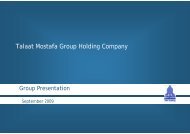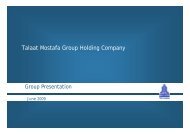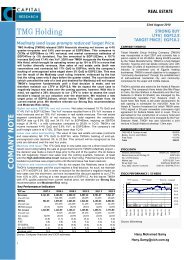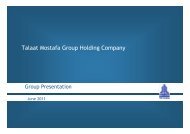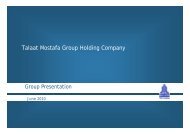Egypt Real Estate Sector - Talaat Moustafa Group
Egypt Real Estate Sector - Talaat Moustafa Group
Egypt Real Estate Sector - Talaat Moustafa Group
You also want an ePaper? Increase the reach of your titles
YUMPU automatically turns print PDFs into web optimized ePapers that Google loves.
05 October 2011<br />
Analysts’ stock ratings are defined as follows:<br />
Outperform (O): The stock’s total return is expected to outperform the relevant benchmark* by at least 10-15% (or more, depending on perceived<br />
risk) over the next 12 months.<br />
Neutral (N): The stock’s total return is expected to be in line with the relevant benchmark* (range of ±10-15%) over the next 12 months.<br />
Underperform (U): The stock’s total return is expected to underperform the relevant benchmark* by 10-15% or more over the next 12 months.<br />
*Relevant benchmark by region: As of 29 th May 2009, Australia, New Zealand, U.S. and Canadian ratings are based on (1) a stock’s absolute total<br />
return potential to its current share price and (2) the relative attractiveness of a stock’s total return potential within an analyst’s coverage universe**,<br />
with Outperforms representing the most attractive, Neutrals the less attractive, and Underperforms the least attractive investment opportunities.<br />
Some U.S. and Canadian ratings may fall outside the absolute total return ranges defined above, depending on market conditions and industry<br />
factors. For Latin American, Japanese, and non-Japan Asia stocks, ratings are based on a stock’s total return relative to the average total return of<br />
the relevant country or regional benchmark; for European stocks, ratings are based on a stock’s total return relative to the analyst's coverage<br />
universe**. For Australian and New Zealand stocks, 12-month rolling yield is incorporated in the absolute total return calculation and a 15% and a<br />
7.5% threshold replace the 10-15% level in the Outperform and Underperform stock rating definitions, respectively. The 15% and 7.5% thresholds<br />
replace the +10-15% and -10-15% levels in the Neutral stock rating definition, respectively.<br />
**An analyst's coverage universe consists of all companies covered by the analyst within the relevant sector.<br />
Restricted (R): In certain circumstances, Credit Suisse policy and/or applicable law and regulations preclude certain types of communications,<br />
including an investment recommendation, during the course of Credit Suisse's engagement in an investment banking transaction and in certain other<br />
circumstances.<br />
Volatility Indicator [V]: A stock is defined as volatile if the stock price has moved up or down by 20% or more in a month in at least 8 of the past 24<br />
months or the analyst expects significant volatility going forward.<br />
Analysts’ coverage universe weightings are distinct from analysts’ stock ratings and are based on the expected<br />
performance of an analyst’s coverage universe* versus the relevant broad market benchmark**:<br />
Overweight: Industry expected to outperform the relevant broad market benchmark over the next 12 months.<br />
Market Weight: Industry expected to perform in-line with the relevant broad market benchmark over the next 12 months.<br />
Underweight: Industry expected to underperform the relevant broad market benchmark over the next 12 months.<br />
*An analyst’s coverage universe consists of all companies covered by the analyst within the relevant sector.<br />
**The broad market benchmark is based on the expected return of the local market index (e.g., the S&P 500 in the U.S.) over the next 12 months.<br />
Credit Suisse’s distribution of stock ratings (and banking clients) is:<br />
Global Ratings Distribution<br />
Outperform/Buy* 49% (61% banking clients)<br />
Neutral/Hold* 39% (56% banking clients)<br />
Underperform/Sell* 9% (55% banking clients)<br />
Restricted 2%<br />
*For purposes of the NYSE and NASD ratings distribution disclosure requirements, our stock ratings of Outperform, Neutral, and Underperform most closely correspond to Buy,<br />
Hold, and Sell, respectively; however, the meanings are not the same, as our stock ratings are determined on a relative basis. (Please refer to definitions above.) An investor's<br />
decision to buy or sell a security should be based on investment objectives, current holdings, and other individual factors.<br />
Credit Suisse’s policy is to update research reports as it deems appropriate, based on developments with the subject company, the sector or the<br />
market that may have a material impact on the research views or opinions stated herein.<br />
Credit Suisse's policy is only to publish investment research that is impartial, independent, clear, fair and not misleading. For more detail please refer to Credit<br />
Suisse's Policies for Managing Conflicts of Interest in connection with Investment Research:<br />
http://www.csfb.com/research-and-analytics/disclaimer/managing_conflicts_disclaimer.html<br />
Credit Suisse does not provide any tax advice. Any statement herein regarding any US federal tax is not intended or written to be used, and cannot<br />
be used, by any taxpayer for the purposes of avoiding any penalties.<br />
See the Companies Mentioned section for full company names.<br />
Price Target: (12 months) for (PHDC.CA)<br />
Method: Our TP is derived from a SOTP valuation whereby we do a DCF for all projects underconstruction using our average WACC of 14.6%. Our<br />
WACC of 14.6% is derived from a cost of equity of 15.3% and cost of debt of 12%.<br />
Risks: 1) Recent land disputes in <strong>Egypt</strong> might negatively affect investor sentiment and may represent a short-term overhang on real estate stocks in<br />
<strong>Egypt</strong>; 2) : Lower than expected sales performance would represent further downside risk; 3) An increase in the rate of cancellations, especially on<br />
the holiday homes front would have further negative impact on our valuation.<br />
Price Target: (12 months) for (OCDI.CA)<br />
Method: Our TP of EGP 15.66 per share is derived from a SOTP valuation whereby we do a DCF for each individual project. We use an average<br />
WACC of 16% in our DCF.<br />
Risks: Risks include political risks in the Middle East, cancellation of sold properties, property sales not materialising and<br />
cancellation of projects amongst others.<br />
Price Target: (12 months) for (TMGH.CA)<br />
Method: Our TP is derived from a SOTP valuation whereby we value each business segment separately; 1) We value TMG's real estate projects<br />
(property sales) and hotels via a DCF approach using our average WACC of 14.4%. We use a terminal growth rate of 3% for hotels; 2) we value<br />
TMG's investment properties by applying a 7% cap rate to 2015E discounted FCF.<br />
<strong>Egypt</strong> <strong>Real</strong> <strong>Estate</strong> <strong>Sector</strong> 14



